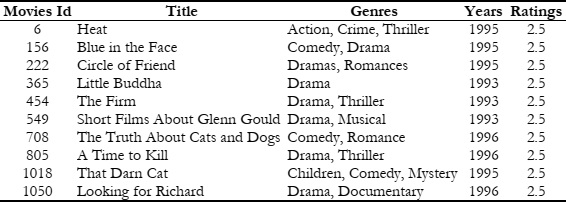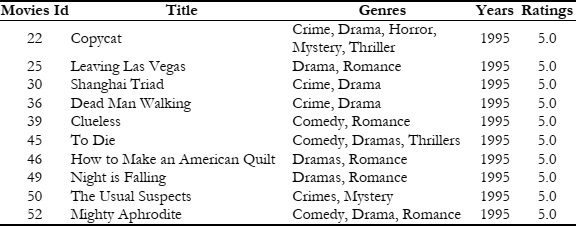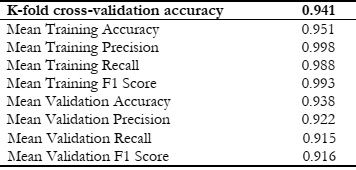It is crucial to evaluate three distinct components: the recommendation of super-user movies, the recommendation of active-user movies, and the recommendation using cosine similarity.
The recommendation for super-user movies demonstrates an almost 100% accuracy rate. This level of accuracy is achieved by directly extracting positive and negative movie selections from the ratings.csv dataset and presenting them in a hierarchical order. This method ensures precise recommendations for the super-user, as it's based on explicit data available in the dataset. The high accuracy in super-user recommendations suggests that this approach is highly effective, benefiting from the clear and direct data source. However, we should further examine the results for the recommendations to active users and those utilizing cosine similarity to provide a comprehensive evaluation.
An accuracy of 85% for the active users has been achieved, because of the selection of positively rated movies for all active users from the ratings.csv dataset and hierarchically present them.
To accomplish this, a random shuffling of the ratings.csv dataset has been done. Next, a 5% portion of the data frame for testing purposes, while allocating the remaining 95% for calculating user similarity and creating the cosine similarity matrix. After generating a confusion matrix, predictions are obtained for every pair of movie IDs and user IDs. We then process the test set to acquire predictions for each user ID and movie ID pair from the confusion matrix, and these predictions are saved as the predicted ratings. The construction of this confusion matrix is based on each user's predicted ratings and the true ratings for the respective movies.
Figure 4 presents a comparative analysis of evaluation metrics, namely precision, recall, and F1-score, for all three types of users. In comparison to super and active users, the passive users received a lower score, attributed to the priorities assigned to this user type, as shown in Figure 4.
[1] S. Berkovsky, T. Kuflik, and F. Ricci, “Mediation of user models for enhanced personalization in recommender systems,” User Model. User-adapt. Interact., vol. 18, no. 3, pp. 245–286, Aug. 2008, doi: 10.1007/S11257-007-9042-9/METRICS.
[2] L. Quijano-Sanchez, J. A. Recio-Garcia, B. Diaz-Agudo, and G. Jimenez-Diaz, “Social factors in group recommender systems,” ACM Trans. Intell. Syst. Technol., vol. 4, no. 1, Feb. 2013, doi: 10.1145/2414425.2414433.
[3] V. R. Yannam, J. Kumar, K. S. Babu, and B. K. Patra, “Enhancing the accuracy of group recommendation using slope one,” J. Supercomput., vol. 79, no. 1, pp. 499–540, Jan. 2023, doi: 10.1007/S11227-022-04664-4/METRICS.
[4] EmamgholizadehHanif, DelićAmra, and RicciFrancesco, “Predicting Group Choices from Group Profiles,” ACM Trans. Interact. Intell. Syst., vol. 14, no. 1, pp. 1–27, Feb. 2024, doi: 10.1145/3639710.
[5] I. Alam and S. Khusro, “Tailoring Recommendations to Groups of Viewers on Smart TV: A Real-Time Profile Generation Approach,” IEEE Access, vol. 8, pp. 50814–50827, 2020, doi: 10.1109/ACCESS.2020.2980206.
[6] I. Alam, S. Khusro, and M. Khan, “Factors Affecting the Performance of Recommender Systems in a Smart TV Environment,” Technol. 2019, Vol. 7, Page 41, vol. 7, no. 2, p. 41, May 2019, doi: 10.3390/TECHNOLOGIES7020041.
[7] I. Alam, S. Khusro, and M. Khan, “Personalized content recommendations on smart TV: Challenges, opportunities, and future research directions,” Entertain. Comput., vol. 38, p. 100418, May 2021, doi: 10.1016/J.ENTCOM.2021.100418.
[8] Y. Afoudi, M. Lazaar, and M. Al Achhab, “Hybrid recommendation system combined content-based filtering and collaborative prediction using artificial neural network,” Simul. Model. Pract. Theory, vol. 113, p. 102375, Dec. 2021, doi: 10.1016/J.SIMPAT.2021.102375.
[9] F. Ortega, R. Hurtado, J. Bobadilla, and R. Bojorque, “Recommendation to Groups of Users Using the Singularities Concept,” IEEE Access, vol. 6, pp. 39745–39761, Jul. 2018, doi: 10.1109/ACCESS.2018.2853107.
[10] Y. Liu, L. Yang, J. Sun, Y. Jiang, and J. Wang, “Collaborative matrix factorization mechanism for group recommendation in big data-based library systems,” Libr. Hi Tech, vol. 36, no. 3, pp. 458–481, Jun. 2018, doi: 10.1108/LHT-06-2017-0121/FULL/XML.
[11] Y. Wang, Z. Dai, J. Cao, J. Wu, H. Tao, and G. Zhu, “Intra- and inter-association attention network-enhanced policy learning for social group recommendation,” World Wide Web, vol. 26, no. 1, pp. 71–94, Jan. 2023, doi: 10.1007/S11280-022-01035-0/METRICS.
[12] “Group Dynamic and Group Recommender Systems for Decision Support.” Accessed: Feb. 20, 2024. [Online]. Available: https://ceur-ws.org/Vol-3177/paper13.pdf
[13] A. Felfernig, L. Boratto, M. Stettinger, and M. Tkalčič, Eds., “Group Recommender Systems,” 2024, doi: 10.1007/978-3-031-44943-7.
[14] L. Sun, X. Wang, Z. Wang, H. Zhao, and W. Zhu, “Social-Aware Video Recommendation for Online Social Groups,” IEEE Trans. Multimed., vol. 19, no. 3, pp. 609–618, Mar. 2017, doi: 10.1109/TMM.2016.2635589.
[15] T. De Pessemier, J. Dhondt, and L. Martens, “Hybrid group recommendations for a travel service,” Multimed. Tools Appl., vol. 76, no. 2, pp. 2787–2811, Jan. 2017, doi: 10.1007/S11042-016-3265-X/METRICS.
[16] G. Adomavicius and A. Tuzhilin, “Toward the next generation of recommender systems: A survey of the state-of-the-art and possible extensions,” IEEE Trans. Knowl. Data Eng., vol. 17, no. 6, pp. 734–749, Jun. 2005, doi: 10.1109/TKDE.2005.99.
[17] F. Ricci, B. Shapira, and L. Rokach, “Recommender systems: Introduction and challenges,” Recomm. Syst. Handbook, Second Ed., pp. 1–34, Jan. 2015, doi: 10.1007/978-1-4899-7637-6_1/COVER.
[18] I. Saifudin and T. Widiyaningtyas, “Systematic Literature Review on Recommender System: Approach, Problem, Evaluation Techniques, Datasets,” IEEE Access, 2024, doi: 10.1109/ACCESS.2024.3359274.
[19] G. Linden, B. Smith, and J. York, “Amazon.com recommendations: Item-to-item collaborative filtering,” IEEE Internet Comput., vol. 7, no. 1, pp. 76–80, 2003, doi: 10.1109/MIC.2003.1167344.
[20] A. S. Das, M. Datar, A. Garg, and S. Rajaram, “Google news personalization: Scalable online collaborative filtering,” 16th Int. World Wide Web Conf. WWW2007, pp. 271–280, 2007, doi: 10.1145/1242572.1242610.
[21] P. Jomsri, D. Prangchumpol, K. Poonsilp, and T. Panityakul, “Hybrid recommender system model for digital library from multiple online publishers,” F1000Research 2023 121140, vol. 12, p. 1140, Sep. 2023, doi: 10.12688/f1000research.133013.1.
[22] “The BellKor Solution to the Netflix Grand Prize.” Accessed: Feb. 20, 2024. [Online]. Available: https://www2.seas.gwu.edu/~simhaweb/champalg/cf/papers/KorenBellKor2009.pdf
[23] M. O’Connor, D. Cosley, J. A. Konstan, and J. Riedl, “PolyLens: A Recommender System for Groups of Users,” ECSCW 2001, pp. 199–218, Dec. 2001, doi: 10.1007/0-306-48019-0_11.
[24] Z. Yu, Z. Yu, X. Zhou, and Y. Nakamura, “Toward an understanding of user-defined conditional preferences,” 8th IEEE Int. Symp. Dependable, Auton. Secur. Comput. DASC 2009, pp. 203–208, 2009, doi: 10.1109/DASC.2009.52.
[25] M. Bałchanowski and U. Boryczka, “A Comparative Study of Rank Aggregation Methods in Recommendation Systems,” Entropy 2023, Vol. 25, Page 132, vol. 25, no. 1, p. 132, Jan. 2023, doi: 10.3390/E25010132.
[26] N. R. Kim and J. H. Lee, “Group recommendation system: Focusing on home group user in TV domain,” 2014 Jt. 7th Int. Conf. Soft Comput. Intell. Syst. SCIS 2014 15th Int. Symp. Adv. Intell. Syst. ISIS 2014, pp. 985–988, Feb. 2014, doi: 10.1109/SCIS-ISIS.2014.7044866.
[27] “On the Move to Meaningful Internet Systems: OTM 2008 Workshops: OTM Confederated International Workshops and Posters, ADI, AWeSoMe, COMBEK, EI2N, IWSSA, MONET, OnToContent & QSI, ORM, PerSys, RDDS, SEMELS, and SWWS 2008, Monterrey, Mexico, November 9-14, 2008, Proceedings | SpringerLink.” Accessed: Feb. 20, 2024. [Online]. Available: https://link.springer.com/book/10.1007/978-3-540-88875-8
[28] Z. Guo, K. Yu, T. Guo, A. K. Bashir, M. Imran, and M. Guizani, “Implicit Feedback-based Group Recommender System for Internet of Things Applications,” 2020 IEEE Glob. Commun. Conf. GLOBECOM 2020 - Proc., vol. 2020-January, Dec. 2020, doi: 10.1109/GLOBECOM42002.2020.9348091.
[29] Z. Papamitsiou and A. A. Economides, “Motivating Students in Collaborative Activities with Game-Theoretic Group Recommendations,” IEEE Trans. Learn. Technol., vol. 13, no. 2, pp. 374–386, Apr. 2020, doi: 10.1109/TLT.2018.2869582.
[30] L. Esmaeili, M. Nasiri, and B. Minaei-Bidgoli, “Personalizing group recommendation to social network users,” Lect. Notes Comput. Sci. (including Subser. Lect. Notes Artif. Intell. Lect. Notes Bioinformatics), vol. 6987 LNCS, no. PART 1, pp. 124–133, 2011, doi: 10.1007/978-3-642-23971-7_18/COVER.
[31] “Setting Goals and Choosing Metrics for Recommender System Evaluations”, [Online]. Available: https://wiki.epfl.ch/edicpublic/documents/Candidacy exam/Evaluation.pdf
[32] H. Ko, S. Lee, Y. Park, and A. Choi, “A Survey of Recommendation Systems: Recommendation Models, Techniques, and Application Fields,” Electron. 2022, Vol. 11, Page 141, vol. 11, no. 1, p. 141, Jan. 2022, doi: 10.3390/ELECTRONICS11010141.
[33] C. Kumar and C. R. Chowdary, “A study on the role of uninterested items in group recommendations,” Electron. Commer. Res., vol. 23, no. 4, pp. 2073–2099, Dec. 2023, doi: 10.1007/S10660-021-09526-4/METRICS.
[34] S. K. Raghuwanshi and R. K. Pateriya, “Recommendation systems: Techniques, challenges, application, and evaluation,” Adv. Intell. Syst. Comput., vol. 817, pp. 151–164, 2019, doi: 10.1007/978-981-13-1595-4_12/COVER.
[35] Y. Pérez-Almaguer, R. Yera, A. A. Alzahrani, and L. Martínez, “Content-based group recommender systems: A general taxonomy and further improvements,” Expert Syst. Appl., vol. 184, p. 115444, Dec. 2021, doi: 10.1016/J.ESWA.2021.115444.
[36] S. B. Royy, L. V. S. Lakshmanan, and R. Liuy, “From group recommendations to group formation,” Proc. ACM SIGMOD Int. Conf. Manag. Data, vol. 2015-May, pp. 1603–1616, May 2015, doi: 10.1145/2723372.2749448.
[37] C. Xiao and C. Xinfei, “Research on the precise marketing method of agricultural products e-commerce platform based on user recommendation algorithm,” 2022 IEEE Asia-Pacific Conf. Image Process. Electron. Comput. IPEC 2022, pp. 519–522, 2022, doi: 10.1109/IPEC54454.2022.9777296.
[38] A. Siddique, M. K. Abid, M. Fuzail, and N. Aslam, “Movies Rating Prediction using Supervised Machine Learning Techniques,” Int. J. Inf. Syst. Comput. Technol., vol. 3, no. 1, pp. 40–56, Jan. 2024, doi: 10.58325/IJISCT.003.01.0062.
[39] J. Ben Schafer, D. Frankowski, J. Herlocker, and S. Sen, “Collaborative filtering recommender systems,” Lect. Notes Comput. Sci. (including Subser. Lect. Notes Artif. Intell. Lect. Notes Bioinformatics), vol. 4321 LNCS, pp. 291–324, 2007, doi: 10.1007/978-3-540-72079-9_9/COVER.
[40] F. O. Isinkaye, Y. O. Folajimi, and B. A. Ojokoh, “Recommendation systems: Principles, methods and evaluation,” Egypt. Informatics J., vol. 16, no. 3, pp. 261–273, Nov. 2015, doi: 10.1016/J.EIJ.2015.06.005.
[41] C. Senot, D. Kostadinov, M. Bouzid, J. Picault, A. Aghasaryan, and C. Bernier, “Analysis of strategies for building group profiles,” Lect. Notes Comput. Sci. (including Subser. Lect. Notes Artif. Intell. Lect. Notes Bioinformatics), vol. 6075 LNCS, pp. 40–51, 2010, doi: 10.1007/978-3-642-13470-8_6/COVER.
[42] Y. Gao and K. Xu, “pRankAggreg: A fast clustering based partial rank aggregation,” Inf. Sci. (Ny)., vol. 478, pp. 408–421, Apr. 2019, doi: 10.1016/J.INS.2018.11.039.
[43] I. Ntoutsi, K. Stefanidis, K. Norvag, and H. P. Kriegel, “gRecs: A group recommendation system based on user clustering,” Lect. Notes Comput. Sci. (including Subser. Lect. Notes Artif. Intell. Lect. Notes Bioinformatics), vol. 7239 LNCS, no. PART 2, pp. 299–303, 2012, doi: 10.1007/978-3-642-29035-0_25/COVER.
[44] J. K. Kim, H. K. Kim, H. Y. Oh, and Y. U. Ryu, “A group recommendation system for online communities,” Int. J. Inf. Manage., vol. 30, no. 3, pp. 212–219, Jun. 2010, doi: 10.1016/J.IJINFOMGT.2009.09.006.
[45] Y. L. Chen, L. C. Cheng, and C. N. Chuang, “A group recommendation system with consideration of interactions among group members,” Expert Syst. Appl., vol. 34, no. 3, pp. 2082–2090, Apr. 2008, doi: 10.1016/J.ESWA.2007.02.008.
[46] J. Guo, Y. Zhu, A. Li, Q. Wang, and W. Han, “A Social Influence Approach for Group User Modeling in Group Recommendation Systems,” IEEE Intell. Syst., vol. 31, no. 5, pp. 40–48, Sep. 2016, doi: 10.1109/MIS.2016.28.
[47] E. Davoodi, M. Afsharchi, and K. Kianmehr, “A social network-based approach to expert recommendation system,” Lect. Notes Comput. Sci. (including Subser. Lect. Notes Artif. Intell. Lect. Notes Bioinformatics), vol. 7208 LNAI, no. PART 1, pp. 91–102, 2012, doi: 10.1007/978-3-642-28942-2_9/COVER.
[48] A. Goel and G. Sahil, “Growth of online social networking and artificial intelligence in digital domain,” AIP Conf. Proc., vol. 2788, no. 1, Jul. 2023, doi: 10.1063/5.0148667/2903948.
[49] R. A. Hamid et al., “How smart is e-tourism? A systematic review of smart tourism recommendation system applying data management,” Comput. Sci. Rev., vol. 39, p. 100337, Feb. 2021, doi: 10.1016/J.COSREV.2020.100337.
[50] N. Pajkovic, “Algorithms and taste-making: Exposing the Netflix Recommender System’s operational logics,” Convergence, vol. 28, no. 1, pp. 214–235, Feb. 2022, doi: 10.1177/13548565211014464/ASSET/IMAGES/LARGE/10.1177_13548565211014464-FIG5.JPEG.
[51] Z. Abbasi-Moud, H. Vahdat-Nejad, and J. Sadri, “Tourism recommendation system based on semantic clustering and sentiment analysis,” Expert Syst. Appl., vol. 167, p. 114324, Apr. 2021, doi: 10.1016/J.ESWA.2020.114324.
[52] C. S. M. Wu, D. Garg, and U. Bhandary, “Movie Recommendation System Using Collaborative Filtering,” Proc. IEEE Int. Conf. Softw. Eng. Serv. Sci. ICSESS, vol. 2018-November, pp. 11–15, Jul. 2018, doi: 10.1109/ICSESS.2018.8663822.
[53] M. Elahi, F. Ricci, and N. Rubens, “A survey of active learning in collaborative filtering recommender systems,” Comput. Sci. Rev., vol. 20, pp. 29–50, May 2016, doi: 10.1016/J.COSREV.2016.05.002.
[54] U. Thakker, R. Patel, and M. Shah, “A comprehensive analysis on movie recommendation system employing collaborative filtering,” Multimed. Tools Appl., vol. 80, no. 19, pp. 28647–28672, Aug. 2021, doi: 10.1007/S11042-021-10965-2/METRICS.
[55] S. Kumar, R. Bhattacharjee, and P. Jeyapandiarajan, “Design and development of longitudinal vehicle dynamics for an All-terrain vehicle,” Mater. Today Proc., vol. 46, pp. 8880–8886, Jan. 2021, doi: 10.1016/J.MATPR.2021.05.085.
[56] P. Nagaraj, P. Deepalakshmi, and M. F. Ijaz, “Optimized adaptive tree seed Kalman filter for a diabetes recommendation system—bilevel performance improvement strategy for healthcare applications,” Cogn. Soft Comput. Tech. Anal. Healthc. Data, pp. 191–202, Jan. 2022, doi: 10.1016/B978-0-323-85751-2.00010-4.

























